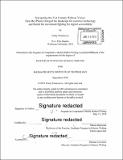Navigating the 21st Century without vision : how the iPhone changed the landscape for assistive technology and fueled the movement fighting for digital accessibility
Author(s)
Pontecorvo, Emily.
Download1139316614-MIT.pdf (1.759Mb)
Alternative title
How the iPhone changed the landscape for assistive technology and fueled the movement fighting for digital accessibility
Other Contributors
Massachusetts Institute of Technology. Department of Comparative Media Studies.
Massachusetts Institute of Technology. Graduate Program in Science Writing.
Advisor
Marcia Bartusiak.
Terms of use
Metadata
Show full item recordAbstract
In 2009, when Apple released the iPhone 3GS, it was the first accessible touchscreen smartphone. This centralized platform, with its built-in GPS, high quality camera, powerful processor, and continuous connectivity, paved the way for new approaches to making a whole range of activities more accessible and convenient for the blind and visually impaired. Where once a blind person might have filled an entire shopping cart with expensive devices that had very specific functions, they could now get nearly all of those services in one device. But even as the iPhone pushed accessibility forward, every door it opened led to another one bolted shut. A blind smartphone user can access mobile apps and social media platforms, but when those applications are not designed to be interpreted by Voiceover, they hit a brick wall. Full accessibility is still either entirely absent from apps, websites, and new devices, or it is thoroughly misguided. The iPhone blurred the line between assistive technology and mainstream technology. It raised the bar for digital accessibility, adding fuel to the fire of the blind community's movement for inclusive design.
Description
Thesis: S.M. in Science Writing, Massachusetts Institute of Technology, Department of Comparative Media Studies/Writing, 2019 Cataloged from PDF version of thesis. Includes bibliographical references (pages 20-21).
Date issued
2019Department
Massachusetts Institute of Technology. Program in Comparative Media Studies/WritingPublisher
Massachusetts Institute of Technology
Keywords
Comparative Media Studies., Graduate Program in Science Writing.